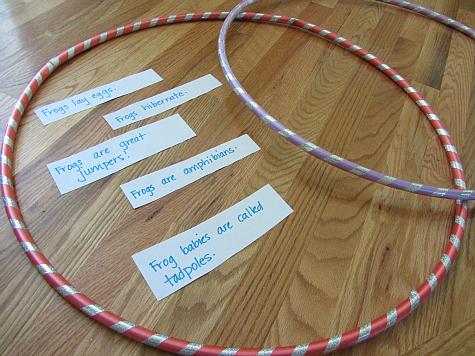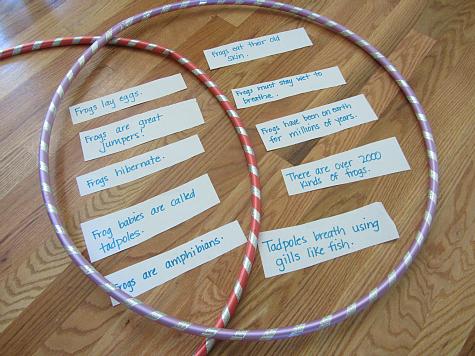As many states adopt the Common Core State Standards into their classrooms, one big change that many students will see is the focus on nonfiction books. This will be a welcome change for some children who enjoy reading to find out facts, but for others who prefer a story and characters to relate to, the change may be a bit of a struggle.
A common literacy practice in classrooms from preschool on up is to retell the story after reading. This boosts comprehension, gives children the chance to focus on what they think key elements of the story are, and gives teachers a clearer view of what students may or may not be comprehending. Retelling with nonfiction isn't really all that different, but I like to make activities like this as active as possible. By making retelling more concrete -- with manipulatives and an oversized diagram made of fun hula hoops -- you add just enough novelty to grab kids' attention. (You can also do some hula hooping when you are done!)
"Show What You Know" is a simple activity. You will need at least two people for this game (you and your child) but it can be played in larger groups, too.
You will need:
2 hula hoops
A nonfiction book
Paper cut into strips
A marker
? Start by placing your hula hoops on the ground so they overlap and form a Venn diagram.
? Then, show your child the book (we used Why Frogs Are Wet by Judy Hawes) and have her list all the things she already knows about the book's subject.
? Write these facts on strips of paper and have your child place them in the left-hand side of the diagram.

? Before you read the book aloud, make sure to tell your child to see if the author mentions any of these facts, and to listen for new ones. This gives children something specific to listen for in addition to the more generic request of listening for new facts.
? Read the book.
? Ask your child to tell you all the new facts she learned in the book.
? Write them down on the paper strips and place them in the right-side of the diagram.
? If some of your previous knowledge facts overlap, move those from the left-side of the diagram to the middle section. (Every one of our facts that we knew already were also mentioned in the book, but if you have facts not mentioned, leave them in the first section.)

Before you grab the hula hoops and shake them, review your diagram with your child. If you feel like she left out important facts, ask her about it. If she is struggling, model for your child and add in your own new facts from the book. You don't have to be too critical; simply say something like, "Remember when the author mentioned this..." or "Oh, we forgot about (fill in the blank)." The goal is to get our kids listening and discerning important facts, but we can still make it fun while they learn these skills.
Do you have a fun activity you do with nonfiction books? Tell us about it! Tweet Allison McDonald @noflashcards or drop us a line on the Scholastic Parents Facebook page.



